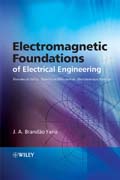
INDICE: PREFACE. To the Electrical Engineer Practitioner. To the Student. To the Instructor. ACKNOWLEDGEMENTS. PROJECT PORTFOLIO. Analysis of a power delivery system. Cylindrical type transmission lines. DC current transducer. Determination of the conductivity of a circular conducting disk. Directional coupler analysis. Ill-defined grounding problems. Induction machine analysis. Line matching technique using an exponential transmission-line section. Linear variable differential transformer. Magnetic actuator and sensor device. Overhead-line protection by ground-wires. Power line carrier communication. Pseudo-balanced three-phase lines. Screened high-voltage three-phase installation. Shielded three-phase cable analysis. Three-route microwave splitter. Transmission-line system with balun transformer for even to odd-mode conversion. Transmission-line system with transformer-stage matching. Two-way loudspeaker analysis. Variable reluctance transformer. PART I: A BRIEF OVERVIEW. INTRODUCTION. CHAPTER 1: BASIC FIELD VECTORS. 1.1: The Electric and Magnetic Field Vectors. 1.2: Constitutive Relations. 1.3: Units and Notation. 1.4: Fundamental Concepts of Voltage and Current Intensity. PART II: STATIONARY FIELD PHENOMENA. INTRODUCTION.CHAPTER 2: ELECTROSTATICS. 2.1 Fundamental Equations. 2.2 Gradient Electric Field, Electric Potential, Voltage, Kirchhoffs Voltage Law. 2.3 Electric Charge, Electric Displacement Vector. 2.4 Dielectric Media, Permittivity, Polarization, Dielectric Strength. 2.5 Conductors in Electrostatic Equilibrium. 2.6 Application Example (Filament of charge). 2.7 Capacitor, Capacitance, Electric Energy. 2.8 Application Example (Two-wire transmission line). 2.9 Multiple Conductor Systems. 2.10 Application Example (Electric coupling in printed circuit boards). 2.11 Electric Forces and Torques. 2.12 Homework Proposed Problems. CHAPTER 3: STATIONARY CURRENTS. 3.1 Fundamental Equations. 3.2 Conductivity, Current Density, Electric Circuits. 3.3 Current Intensity, Kirchhoffs Current Law. 3.4 Resistor, Conductance, Resistance, Ohm's Law. 3.5 Application Example (Thepotentiometer). 3.6 Application Example (The Wheatstone bridge). 3.7 Joule Losses, Generator Applied Field. 3.8 Generator Electromotive Force, Power Balance. 3.9 Homework Proposed Problems. CHAPTER 4: MAGNETIC FIELD OF STATIONARY CURRENTS. 4.1 Fundamental Equations. 4.2 Ampères Law, Magnetomotive Force, Magnetic Voltage. 4.3 Magnetic Induction Field, Magnetic Induction Flux. 4.4 Application Example (Power line magnetic fields). 4.5 Magnetic Materials, Ferromagnetic Media, Saturation and Hysteresis. 4.6 Magnetic Circuits. 4.7 Application Example (Three-legged transformer). 4.8 Magnetic Reluctance. 4.9 Inductor, Inductance, Magnetic Flux Linkage, Magnetic Energy. 4.10 Application Example (Coaxial cable). 4.11 Hysteresis Losses. 4.12 Multiple Circuit Systems. 4.13 Magnetic Forces and Torques. 4.14 Application Example (U-shaped electromagnet). 4.15 Homework Proposed Problems. PART III: SLOW TIME-VARYING FIELDS. INTRODUCTION. CHAPTER 5: MAGNETIC INDUCTION PHENOMENA. 5.1 Fundamental Equations. 5.2 Gradient and Induction Electric Fields, Potential Vector. 5.3 Revisiting the VoltageConcept. 5.4 Induction Law. 5.5 Application Example (Magnetic noise effects).5.6 Voltages and Currents in Magnetically Multicoupled Systems. 5.7 Application Example (Magnetic coupling in printed circuit boards). 5.8 Eddy Currents. 5.9 Generalization of the Induction Law to Moving Circuit Systems. 5.10 Application Example (Electromechanical energy conversion). 5.11 DC Voltage Generation. 5.12 AC Voltage Generation. 5.13 Homework Proposed Problems. CHAPTER 6: ELECTRIC INDUCTION PHENOMENA. 6.1 Fundamental Equations. 6.2 Displacement Current,Generalized Ampères Law. 6.3 Charge Continuity Equation. 6.4 Revisiting the Current Intensity Concept. 6.5 Application Example (Capacitor self-discharge). 6.6 Voltages and Currents in Electrically Multicoupled Systems. 6.7 Homework Proposed Problems. CHAPTER 7: LUMPED PARAMETERS CIRCUIT ANALYSIS. 7.1 Introduction. 7.2 Steady-State Harmonic Regimes. 7.3 Transformer Analysis. 7.4 Transient Regimes. 7.5 Homework Proposed Problems. PART IV: RAPID TIME-VARYING FIELDS.INTRODUCTION. CHAPTER 8: ELECTROMAGNETIC FIELD PHENOMENA. 8.1 ElectromagneticWaves. 8.2 Poyntings Theorem, Poyntings Vector, Power Flow. 8.3 Time-HarmonicFields, Field Polarization, RMS Field Values. 8.4 Phasor-Domain Maxwell Equations, Material Media Constitutive Relations. 8.5 Application Example (Uniform plane waves). 8.6 Complex Poyntings Vector. 8.7 Application Example (Skin effect). 8.8 Homework Proposed Problems. CHAPTER 9: TRANSMISSION LINE ANALYSIS. 9.1 Introduction. 9.2 Time-Domain Transmission-Line Equations for Lossless Lines. 9.3 Application Example (Parallel-plate transmission line). 9.4 Frequency-Domain Transmission-Line Equations for Lossy Lines. 9.5 Frequency-Domain Transmission-Line Equations for Lossless Lines. 9.6 Application Example (Line matching techniques). 9.7 Multiconductor Transmission Lines. 9.8 Application Example (Even and odd modes). 9.9 Homework Proposed Problems. APPENDICES. Appendix 1: Formulas from Vector Analysis. Appendix 2: Lorentz Transformation. Appendix 3:Elements of Complex Algebra. Appendix 4: Elements of Fourier Analysis. BIBLIOGRAPHY. INDEX.
- ISBN: 978-0-470-72709-6
- Editorial: John Wiley & Sons
- Encuadernacion: Cartoné
- Páginas: 424
- Fecha Publicación: 15/08/2008
- Nº Volúmenes: 1
- Idioma: Inglés
